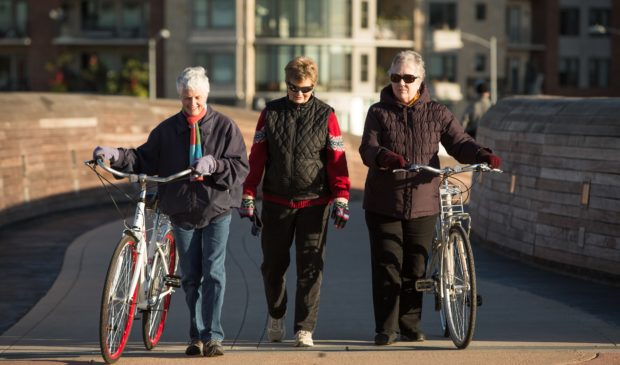Healthy Streets inspires slow streets pilot
Thursday, October 1, 2020 by
Ryan Thornton With cases of Covid-19 on the decline in Austin, the Transportation Department is preparing to wind down the Healthy Streets initiative, a safe mobility and social distancing program that’s been in effect since May 22. The department will start by removing the Whispering Oaks Drive and part of the Comal Street segments at the end of this week and will gradually remove the remaining segments over the coming weeks until all eight are removed. In the long term, elements of the initiative will be incorporated into a slow streets pilot program.
Within 6-12 months, Austin Transportation plans to bring Council recommendations for a slow streets pilot using several of the lessons learned over the course of the Healthy Streets initiative. The slow streets pilot will ultimately help the department develop relatively low-cost strategies and tools to supplement and connect the city’s deficient sidewalk network.
“The streets that don’t have sidewalks right now, they haven’t been built likely for a reason, and that’s because they’re really expensive,” Anna Martin, assistant director of Austin Transportation, told the Austin Monitor Wednesday. “So if we can put a toolbox together of low-cost treatments and provide a safe space for everyone, they’ll certainly let us expand our reach of the pedestrian network and get us to the place where we have pedestrian access citywide.”
Among the traffic calming strategies deployed for the Healthy Streets program, Martin said the most effective was a tool known as a midblock chicane, a barrel in the middle of a road to cause drivers to slow down, pay closer attention and take turns. Martin said the tool will likely be part of the slow streets set of strategies, though the movable barrels may be replaced by rain gardens or landscaping for permanent projects.
Slow streets strategies like the chicane will also be included in the city’s revised draft Transportation Criteria Manual, which is set to be ready this fall, as well as the revision to the 2016 Sidewalk Plan, which will likely be complete within 18-24 months from now.
In May, City Council passed the Healthy Streets resolution with direction to continue the program as long as social distancing remains a community need. With the seven-day moving average of daily hospitalizations down from its peak of over 75 in early July to 12, Transportation is ready to phase the program out. However, in a memo this week, Transportation Director Robert Spillar clarified that new Healthy Streets will be “quickly identified” if there is a surge in cases.
On Thursday, Council will consider an additional $400,000 for Toole Design Group, the firm helping the city update its sidewalk and urban trails plans to align with the goals of the Austin Strategic Mobility Plan. In June, Richard Mendoza, director of the Public Works Department, said new insights from the Healthy Streets initiative – along with Project Connect, Vision Zero and Safe Routes to School planning – were also among the reasons to update the sidewalk plan.
The slow streets strategies will be included in the new sidewalk plan as alternatives to sidewalks in the case of engineering constraints or lack of funding. Due to the cost of sidewalks, the city would need over $1 billion to construct over 2,500 miles of concrete to complete the sidewalk network. The 390-mile network of missing high- and very-high-priority sidewalks would cost roughly $250 million, $80 million of which will be funded if voters approve Proposition B next month. (View a map of the sidewalk network gaps.)
As the Healthy Streets program is phased out, the city is adding sidewalks to the Northeast Austin segment of Belfast Drive between Cameron Road and Broadmoor Drive. The active mobility lane at Longhorn Dam on Pleasant Valley Road is also being converted into a long-term facility.
“The Healthy Streets program has been a huge success during its short implementation,” Council Member Paige Ellis, sponsor of the resolution, told the Monitor in an email. “The Transportation and Public Works departments will continue to work on initiatives that will improve street safety. The Healthy Streets formula is available to test ideas and locations for more permanent street safety improvements and connect gaps in our bicycle/pedestrian network.”
Martin said the department also discovered through Healthy Streets that slow streets are most popular and effective on streets without existing sidewalks and that the tools can be compatible with public transit as long as the transit vehicles and passenger access are considered in the design.
Download (PDF, 96KB)
Photo made available through a Creative Commons license.
The Austin Monitor’s work is made possible by donations from the community. Though our reporting covers donors from time to time, we are careful to keep business and editorial efforts separate while maintaining transparency. A complete list of donors is available here, and our code of ethics is explained here.
You're a community leader
And we’re honored you look to us for serious, in-depth news. You know a strong community needs local and dedicated watchdog reporting. We’re here for you and that won’t change. Now will you take the powerful next step and support our nonprofit news organization?











